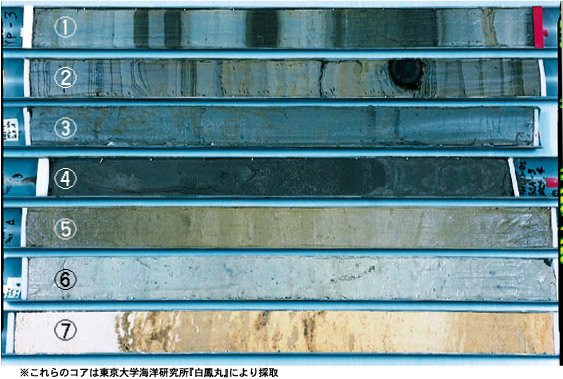|
|
 Understanding the Earth's Environmental Understanding the Earth's Environmental
SystemClimate Change: Causes, Processes, and Effects
Global climatic changes are complicated natural phenomena related to the solar activity, material cycles in the atmosphere-ocean-land system, and the ecosystem. Determining the driving mechanisms, and processes of climate change will help us to understand the natural climatic variability of the Earth, and will be the key to predicting future climatic changes.
|
|
Subseafloor Material Cycles and Gas Hydrates
Extensive reservoirs of methane hydrates beneath the deep sea floor have been reported on previous ocean drilling legs. Drilled samples provide valuable information regarding their possible impacts on the global carbon budget, and their resource potential. Methane is also recognized as an important greenhouse gas. Thus, we need to know about the interactions between the carbon cycle and deep biosphere under the seafloor.
|
|
 Environmental Information from the Sedimentary Record Environmental Information from the Sedimentary Record
The ocean is an important area of the Earth, because seawater has the potential to absorb greenhouse gases such as carbon dioxide from the atmosphere. The dissolved carbon dioxide in seawater is then used by marine phytoplankton for photosynthesis. Organic compounds and plankton tests produced in the surface waters eventually sink through the water column, some of which decompose or dissolve on route to the sea floor to input nutrients and carbon dioxide into the intermediate and deep waters. The remainder arrives at the sea floor and may become incorporated into the sediments. Terrestrial materials and aerosols are also transported to the ocean via atmospheric circulation and/or river input. Using a multidisciplinary approach (such as geochemical, micropaleontological, and isotopic signals) we can reconstruct past material cycles and oceanographic changes from deep-sea cores.
|
 Coring Process Coring Process
Long cores have been taken now from most of the World's oceans (which cover 70% of the Earth's surface) and have provided us with a global picture of past climate. The deep sea drilling ship can acquire marine cores several hundreds of meters long from the sea floor. In general, drilling at sea uses the same methods as those on land, however, problems arise because the ship is an unstable platform from which several kilometers of pipes are needed to reach the sea floor prior to drilling.
In the Ocean Drilling Program (ODP) it is possible to drill as far as 2 km under the sea floor, but this is not deep enough to address current research issues. Now in Japan, a large research ship "Chikyu" equipped with a riser drilling system has been built by the Japan Marine Science & Technology Center (JAMSTEC). The new ship will play a major role in the Integrated Ocean Drilling Program (IODP) which starts in October 2003, with scientific drilling commencing from 2006.
|
 Marine Core Samples Marine Core Samples
Marine cores, which are taken from the deep sea floor during cruises by several research ships and drilling ships, are good recorders of past global climate changes such as sea level change, paleomagnetic field, ocean circulation, and sea water temperature.

1: Japan Sea (color alternation)
2: Japan Sea (laminated sediments)
3: East China Sea (hemiperagic sediments)
4: Arabian Sea (calcareous ooze)
5: Arabian Sea (calcareous ooze)
6: Sulu Sea (calcareous ooze)
7: Southern Ocean (diatom ooze)
※These cores were recovered during cruises by the R/V Hakuho-Maru, Ocean Research Institute, University of Tokyo.
|
 Core Analysis Flow-Chart Core Analysis Flow-Chart
Step 1: Non-invasive measurements
Non-invasive measurements of the core samples provide sequential digital data on sediment structure and physical properties prior to more detailed invasive analyses. The provisional data-set gives us general information from which the subsequent sampling strategy can be formulated.
Step 2: Sampling
After the non-destructive measurements have been completed, each piston core is halved longitudinally using a core cutter or wire. One of the halves is called the working half which is sampled at certain depth intervals for further analysis, while the other half, called the archive half, is kept in the core repository in reserve.
 
Step 3: Analyses and measurements
Individual samples taken from the working half of the cores are distributed to each laboratory (micropaleontology, physical property, sedimentology, paleomagnetism, organic chemistry, inorganic chemistry, and microbiology) for detailed observations, analyses or measurements.
Step 4: Storage
The core repository is continuously monitored to avoid fluctuations in temperature and humidity, so that the archive halves are kept in good condition. For microbiological samples, supercold conditions are needed to prevent oxidation and chemical breakdown.
|
|